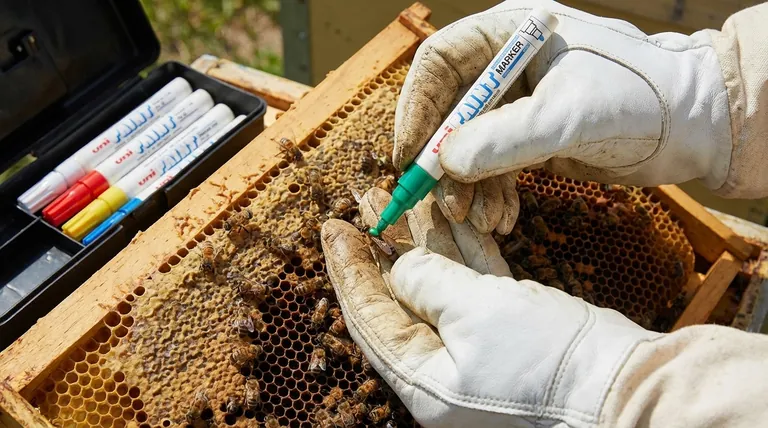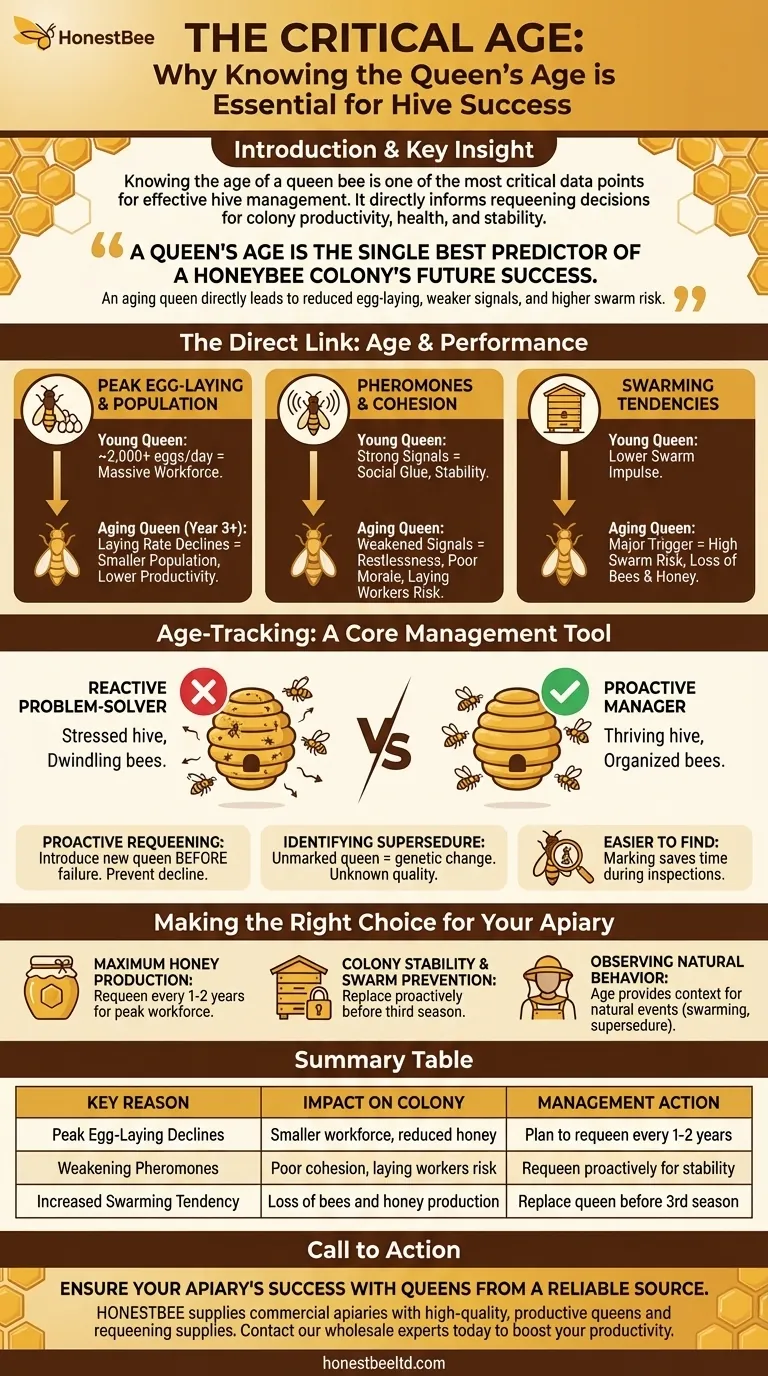Knowing the age of a queen bee is one of the most critical data points for effective hive management. It directly informs a beekeeper's decision on when to replace her, a process known as requeening, which is essential for maintaining a colony's productivity, health, and long-term stability.
A queen's age is the single best predictor of a honeybee colony's future success. An aging queen directly leads to reduced egg-laying, weaker chemical signals, and a higher chance of swarming, making age-tracking a cornerstone of proactive beekeeping.

The Direct Link Between Queen Age and Colony Performance
The queen is the heart and soul of the colony. Her individual performance dictates the strength and character of the tens of thousands of bees she mothers. As she ages, key aspects of her performance naturally decline.
Peak Egg-Laying and Population
A young, well-mated queen is an egg-laying machine, capable of laying over 2,000 eggs per day. This prolific output creates the massive workforce needed for foraging and honey production.
This peak performance typically lasts for her first or second year. After that, her laying rate begins to decline, leading to a smaller population and a less productive hive.
Pheromones and Colony Cohesion
The queen produces powerful chemical signals, or pheromones, that act as the social glue for the colony. These signals let the workers know their queen is present, healthy, and viable.
As a queen ages, her pheromone output weakens. This can lead to restlessness, poor morale, and even the development of laying workers, which can be catastrophic for a colony.
Swarming Tendencies
A colony's instinct to swarm—where the old queen leaves with half the bees to start a new colony—is a primary challenge for beekeepers.
An aging queen is a major trigger for swarming. A decline in her egg-laying rate and pheromone output signals to the bees that it is time to raise a new queen and for the old one to depart.
Why Age-Tracking is a Core Management Tool
Simply knowing the queen's age transforms your role from a reactive problem-solver to a proactive manager. It allows you to anticipate the colony's needs before they become critical issues.
Proactive Requeening
Knowing your queen is entering her third year allows you to requeen on your schedule. You can introduce a new, young queen before the old one fails, preventing a period of weakness and decline.
Waiting until you see the symptoms of a failing queen—a spotty brood pattern, a dwindling population—means the hive is already in a state of stress and decline.
Identifying Supersedure
Sometimes, the bees decide to replace their own queen in a process called supersedure. If your queen was marked, finding an unmarked queen instantly tells you that supersedure has occurred.
This is vital information. It tells you the genetics of your hive have changed, and the new queen's quality (specifically her mating) is unknown.
Making a Queen Easier to Find
A practical benefit of tracking a queen's age is that it usually involves marking her with a small, brightly colored dot. This simple mark makes finding her among thousands of other bees dramatically faster, saving significant time during hive inspections.
Making the Right Choice for Your Apiary
Understanding the impact of a queen's age empowers you to manage your colonies in line with your specific goals.
- If your primary focus is maximum honey production: You must track your queen's age and plan to requeen every one to two years to maintain a peak workforce.
- If your primary focus is colony stability and swarm prevention: Replacing queens proactively before they enter their third season is a key strategy to reduce the natural swarming impulse.
- If your primary focus is observing natural bee behavior: Knowing the queen's age still provides crucial context for why a hive swarms or supersedes its queen, even if you don't intervene.
Ultimately, tracking your queen's age gives you the insight needed to ensure your colonies don't just survive, but thrive.
Summary Table:
| Key Reason | Impact on Colony | Management Action |
|---|---|---|
| Peak Egg-Laying Declines | Smaller workforce, reduced honey production | Plan to requeen every 1-2 years for maximum yield |
| Weakening Pheromones | Poor colony cohesion, risk of laying workers | Requeen proactively to maintain hive stability |
| Increased Swarming Tendency | Loss of bees and honey production | Replace queen before 3rd season to prevent swarming |
Ensure your apiary's success with queens from a reliable source. HONESTBEE supplies commercial apiaries and beekeeping equipment distributors with the high-quality, productive queens and requeening supplies needed to maintain strong, profitable colonies. Contact our wholesale experts today to discuss your apiary's needs and boost your productivity.
Visual Guide

Related Products
- Queen Bee Marking Pen UNI Medium Point for Queen and Bee Marking
- Jenter Queen Rearing Kit Complete Set for Bee Breeding
- Nicot Queen Rearing Kit for Beekeeping and Grafting in Nicot System
- No Grafting Queen Rearing Kit: System for Royal Jelly Production and Queen Rearing
- Retractable Chinese Queen Rearing Grafting Tools Equipment
People Also Ask
- What are the advantages of using Uni-Posca markers for Queen marking? A Safe, Precise, and Efficient Solution
- What is the process for priming a paint pen before marking a Queen bee? Ensure a Safe, Quick Marking Procedure
- What type of pen is used to mark a queen bee? A Guide to Safe, Effective Hive Management
- What type of markers are commonly used for marking Queen bees? Choose the Safe, Non-Toxic Standard
- What are the color codes in the queen-marking system? Master Hive Management with the 5-Year Cycle



















